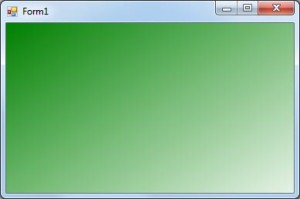Tag Archives: snippet
Custom form background color
Winforms by default don’t offer much customization as far as coloring, especially when it comes down to gradient patterns.
If you want to change the background of your form to something a bit more unique to make it look like this

then simply follow steps below.
First handle the form’s Paint event.
1 2 3 4 5 6 7 8 | private void Form1_Paint(object sender, PaintEventArgs e) { Graphics g = e.Graphics; Rectangle rect = new Rectangle(0, 0, this.Size.Width, this.Size.Height); LinearGradientBrush brush = new LinearGradientBrush(rect, Color.Green, Color.White, LinearGradientMode.ForwardDiagonal); g.FillRectangle(brush, rect); brush.Dispose(); } |
Feel free to change the colors and the gradient direction to what you would like.
Posted in C#.
Tagged C#, csharp, custom form background color, form background color, snippet, winforms
Benchmarking your code
Benchmarking your code is very important since it allows you to pinpoint bottlenecks in your application and allows you to improve the overall performance of your software as well as learning which techniques are more taxing than others.
For this example we are going to be using the Stopwatch class. This class will enable us to see how many milliseconds it required for our code to be executed so we can compare different methods or techniques.
As an example, the code below checks the performance difference of a try/catch block in a loop vs the performance when not using one. Keep in mind that try/catch blocks are not that performance heavy if they don’t actually catch something but the performance gets hit a lot in cases a lot of exceptions are being thrown.
1 2 3 4 5 6 7 8 9 10 11 12 13 14 15 16 17 18 19 20 21 22 23 24 25 26 27 28 29 | Stopwatch sw = new Stopwatch(); int test; //test 1 sw.Start(); test = 0; for (int i = 0; i < int.MaxValue; i++) { test = i; } Console.WriteLine(sw.ElapsedMilliseconds); // 7644 sw.Reset(); //test 2 sw.Start(); test = 0; for (int i = 0; i < int.MaxValue; i++) { try { test = i; } catch { } } Console.WriteLine(sw.ElapsedMilliseconds); // 8429 sw.Reset(); |
For even better results I would advise running each test 3 to 5 times and simply calculating the average time of execution.
Minimize a form without border using the taskbar
By default borderless forms are not designed to be minimized, which means when the form’s FormBorderStyle property is set to None you will notice that clicking the application box in taskbar does not minimize the form.
This can be fixed by overriding CreateParams and adding the WS_MINIMIZEBOX style to the Window and CS_DBLCLKS to the Window class styles.
Simply place the following code inside your Form’s class which you want to enable the minimize functionality using the taskbar.
1 2 3 4 5 6 7 8 9 10 11 12 13 | const int WS_MINIMIZEBOX = 0x20000; const int CS_DBLCLKS = 0x8; protected override CreateParams CreateParams { get { CreateParams cp = base.CreateParams; cp.Style |= WS_MINIMIZEBOX; cp.ClassStyle |= CS_DBLCLKS; return cp; } } |
Posted in C#.
Tagged C#, CS_DBLCLKS, csharp, FormBorderStyle, snippet, winforms, WS_MINIMIZEBOX








